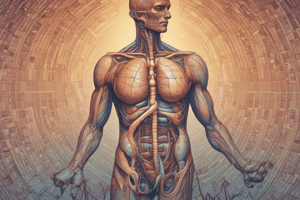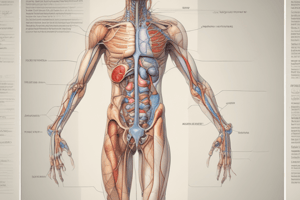Podcast
Questions and Answers
What is the primary purpose of the scrotum?
What is the primary purpose of the scrotum?
- To produce sperm
- To connect the testes to the abdominal cavity
- To produce testosterone
- To maintain a low temperature necessary for spermatogenesis (correct)
During which month of foetal life do the testes descend into the scrotal sacs?
During which month of foetal life do the testes descend into the scrotal sacs?
- 5th month
- 10th month
- 9th month
- 7th month (correct)
What is cryptorchidism?
What is cryptorchidism?
- The production of testosterone
- The descent of the testes into the scrotal sacs
- The failure of the testes to descend into the scrotal sacs (correct)
- The removal of the testes
What connects the scrotum to the abdomen or pelvic cavity?
What connects the scrotum to the abdomen or pelvic cavity?
What is the temperature difference between the scrotum and the internal body temperature?
What is the temperature difference between the scrotum and the internal body temperature?
What is the effect of castration?
What is the effect of castration?
Why were choir boys often castrated in medieval Europe?
Why were choir boys often castrated in medieval Europe?
What is the result of castration on an aggressive bull?
What is the result of castration on an aggressive bull?
What is the shape of an adult testis?
What is the shape of an adult testis?
What is the function of Sertoli cells in the seminiferous tubules?
What is the function of Sertoli cells in the seminiferous tubules?
What is the approximate length of an adult testis?
What is the approximate length of an adult testis?
What is the purpose of the tunica albuginea in the testis?
What is the purpose of the tunica albuginea in the testis?
What is the function of the seminiferous tubules in the testis?
What is the function of the seminiferous tubules in the testis?
What is the name of the protein released by Sertoli cells to prevent the development of the mullerian duct in males?
What is the name of the protein released by Sertoli cells to prevent the development of the mullerian duct in males?
Flashcards are hidden until you start studying
Study Notes
Testes and Scrotum
- The testes are located outside the abdominal cavity within a pouch called the scrotum.
- The scrotum helps maintain a lower temperature (2-2.5°C lower than normal body temperature) necessary for spermatogenesis.
- During the 7th month of fetal life, the testes descend into the scrotal sacs in the presence of testosterone hormone.
Development and Structure of Testes
- Each testis is oval in shape, approximately 4-5 cm in length and 2-3 cm in width.
- The testis is covered by a dense covering and enclosed in an outer tough capsule of collagenous connective tissue called the tunica albuginea.
- Each testis has about 250 compartments called testicular lobules, which contain highly coiled tubules called seminiferous tubules.
- Each seminiferous tubule is lined by two types of cells: male germ cells (spermatogonia) and Sertoli cells.
Functions of Sertoli Cells
- Provide nourishment to developing spermatozoa and regulate spermatogenesis by releasing inhibin to check FSH over-activity.
- Absorb parts being shed by developing spermatozoa.
- Release anti-müllerian factor (AMF) to prevent development of müllerian duct/oviduct in males.
- Release Androgen Binding Protein (ABP).
- Form blood-testis barrier.
Castration
- Castration is the removal of testes, leading to failure of development of secondary sex organs and characters, and removing the ability to reproduce due to a deficiency of testosterone.
Studying That Suits You
Use AI to generate personalized quizzes and flashcards to suit your learning preferences.



